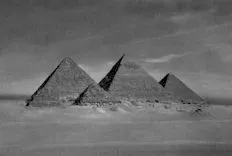Part I: God’s Word Given to Man
The year is around 1446 B.C., and Moses has just led the Israelites out of slavery in Egypt. At the time, Egypt was one of the most advanced civilizations in the world, known for its achievements in architecture, writing, and mathematics. However, Egyptian society was built on a strict hierarchy, and not all people were considered equal. For generations, the Israelites labored under Pharaoh’s rule and were forced to build monuments to leaders who were worshipped as gods. The Pyramids of Giza, which still stand today, serve as a testament not only to Egypt’s grandeur but also to the forced labor of enslaved peoples.
Pharaoh Ramesses II had grand plans to use Israelite labor for his massive construction projects, but according to biblical tradition, God had a different plan. Through a series of miraculous events recorded in Exodus (chapters 7–14), Moses—despite his own doubts and shortcomings—led his people to freedom. The final miracle, the parting of the Red Sea, allowed the Israelites to escape their oppressors and begin a new chapter in their history. Now, at Mount Sinai, Moses was called into God’s presence to receive the foundation of Israel’s spiritual and legal system: the Ten Commandments. This moment marked the beginning of a sacred tradition that would shape religious thought for thousands of years.

The biblical account in the King James Version describes this pivotal event:
*"And he hewed two tables of stone like unto the first; and Moses rose up early in the morning, and went up unto mount Sinai, as the Lord had commanded him, and took in his hand the two tables of stone. And the Lord descended in the cloud, and stood with him there, and proclaimed the name of the Lord… And He said, 'Behold, I make a covenant: before all thy people I will do marvels, such as have not been done in all the earth, nor in any nation: and all people among which thou art shall see the work of the Lord'… And the Lord said unto Moses, 'Write down these words: for after the tenor of these words I have made a covenant with thee and with Israel.' And he was there with the Lord forty days and forty nights; he did neither eat bread, nor drink water. And he wrote upon the tablets the words of the covenant, the Ten Commandments." (Exodus 34)
From this point forward, the Bible began to take shape. The first five books, traditionally attributed to Moses and known as the Pentateuch, were written in Hebrew. Over the next thousand years, more books were added, covering history, prophecy, poetry, and wisdom literature. By around 444 B.C., the Hebrew Bible—what Christians call the Old Testament—was complete, serving as the foundation for Jewish religious life.
How the Bible Came Together
The term canon refers to the official collection of writings that make up the Bible. These writings were considered divinely inspired and set apart from other religious or historical texts. The canon was not determined by a single event but developed over centuries. The Old Testament, written long before the birth of Jesus, contains prophecies about a coming Messiah. After the last book of the Old Testament was written around 400 B.C., no new scripture was recognized for several hundred years—this period is often called the “silent years.”
That silence ended with the life of Jesus. His followers, known as the apostles, began writing about his teachings, miracles, death, and resurrection. Along with letters written to early Christian communities, these texts formed what is now known as the New Testament. As Christianity spread, the early church recognized these writings as sacred scripture. By the fourth century A.D., church councils officially affirmed the New Testament canon, concluding that no new inspired scripture was being written. Since then, both Protestant and Catholic traditions have recognized the Bible as a complete and authoritative record of God’s message to humanity.
While Christians accept both the Old and New Testaments as scripture, Jewish tradition only considers the Hebrew Bible to be sacred. This difference is reflected in Romans 9:31–33, which describes Israel’s struggle with faith in Jesus as the Messiah:
"But Israel, which followed after the law of righteousness, hath not attained to the law of righteousness. Wherefore? Because they sought it not by faith, but as it were by the works of the law. For they stumbled at that stumblingstone; As it is written, Behold, I lay in Sion a stumblingstone and rock of offence: and whosoever believeth on him shall not be ashamed."
During the centuries surrounding Jesus’ life, many religious writings circulated, some of which referenced biblical themes. While these texts were valued for their historical and literary significance, most early church councils did not recognize them as divinely inspired. However, some of these writings were included in a special section of the Catholic Bible called the Apocrypha.
Preserving the Bible Through the Ages
The origins of the Bible trace back to the time of Moses in the 15th century B.C., when God’s words were first recorded in Hebrew. As Exodus 24:4 states, “And Moses wrote all the words of the LORD, and rose up early in the morning, and builded an altar under the hill, and twelve pillars, according to the twelve tribes of Israel.” The first five books of the Bible, the Pentateuch, were placed in the Ark of the Covenant (Deuteronomy 31:26) and served as the foundation for Israel’s laws and religious practices.
Over the next thousand years, the collection of Hebrew scriptures expanded as God’s message was recorded through leaders such as Joshua, Samuel, and the prophets. As these writings were passed down, they had to be carefully copied to ensure accuracy. The Jewish scribes, entrusted with this responsibility, played a crucial role in preserving scripture for future generations. Their dedication ensured that these sacred texts would endure, ultimately shaping the religious beliefs of countless people throughout history.
